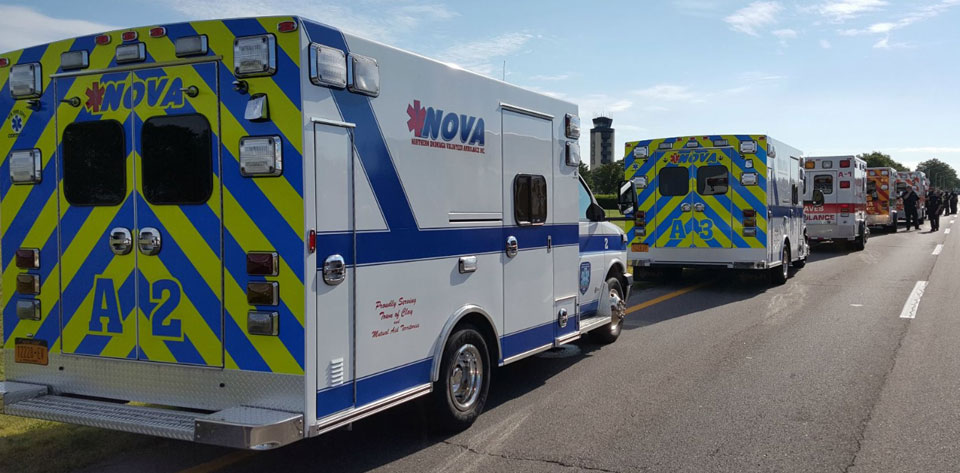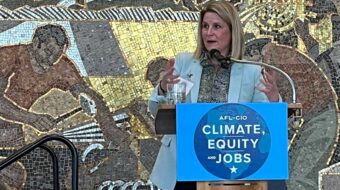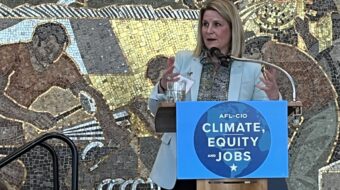
Earlier this month, emergency medical services workers near Syracuse, NY, voted overwhelmingly to join the Civil Service Employees Association (CSEA). Organizing efforts were boosted by management’s dismal response to the COVID-19 crisis as well as its hostile anti-union campaign in the summer. In the end, the workers employed by the Northern Onondaga Volunteer Ambulance (NOVA), a not-for-profit company, voted “Union, Yes” 15 to 6, with only three eligible workers choosing to not vote.
Because of the coronavirus, the National Labor Relations Board tallied the ballots over a Zoom call. The core group of three—workplace organizers Ethan Darbee and Matt Miller, and CSEA organizer Adam Pelletier—sat in Darbee’s living room during the call. “As the results were coming in, the three of us couldn’t stop smiling. We felt the electricity in the air,” Darbee told People’s World. Without coming off as rude, they left the call as soon as the voting was over and erupted in cheers, hugs, and high fives. Workers on duty in the station during the vote felt the same energy.
The process began in the summer of 2019 when Darbee and Miller randomly emailed and filled out contact forms with an array of unions. None responded.
The two persisted. At the New York State Fair in August last year, Darbee swung by the CSEA booth, and that union took his efforts seriously. CSEA counseled him to carefully and slowly approach his coworkers, to minimize exposure to management.
By the time the coronavirus struck in March, Darbee and Miller estimated they had gained the support of about half the workforce. With the pandemic throwing major stress onto the industry, Darbee and the union opted to slow things down. By the summer, management’s haphazard reply to the virus confirmed the thinking of the already pro-union crowd and pushed those in the middle crowd into sympathy with the drive.
The first company communication to the workforce about COVID-19 was on March 19, a full month and a half after Pres. Trump’s declaration of a public health emergency on Feb. 3. Much worse was how management dealt with a possible spreading of the virus. Removed from the station were all pots, pans, silverware, even the coffee maker. But the large boxes of plastic cutlery remained, and it is impossible to touch only one fork or spoon in the box. But that was the least of the blunders.
The workforce wanted the last 30 minutes of the shifts dedicated to wiping clean their entire rigs. That would have required NOVA to institute an end-of-shift period, where crews could clean the vehicles instead of possibly getting a late call. When management learned of the idea, it made it clear that would never happen.
Fitting the national pattern of inadequate supplies, NOVA did not have enough personal protective equipment. “The agency was woefully unprepared,” said one worker, who requested anonymity. “The stockpile of PPE was so low, it was left scrambling for supplies. And it had to pay top dollar to get the needed equipment.”
More salt in the wound was the sudden disappearance of the station’s showers. Quite a few workers, especially those with children and spouses, showered after their shifts, bagging their uniforms before leaving for home. The showers were removed during a major renovation of the station but without warning. This jeopardized spreading the virus to family members.
The push to unionize in the first place was a bit ironic. NOVA has good equipment, high-quality ambulances, and provides durable uniforms. Management has been flexible with many of its decisions.
“Equipment wise, we are better off than many other agencies in the area,” Darbee explained. “But the conditions of being an EMS worker are tough and morale was low. Their confusion during the pandemic was an eye-opener.”
The core group set a goal: get informal pledges of support from three-fourths of twenty workers—all full-timers and part-timers who worked at least 24 hours a week. When they did this by early August, Darbee gave his boss a letter requesting voluntary recognition.
Rather, management delivered voluntary resistance. In September, the company decided to water down the union support by pushing for all 37 employees to be eligible to vote. This would have dropped the pro-union crowd from 75% to less than half. Union and company lawyers negotiated and settled on 24 eligible voters. That number included any employee that met the National Labor Relations Board minimum requirement of hours worked.
Over Labor Day weekend, out-of-state union busters arrived in helicopters. They were in the station for hours every day for several weeks. Mandatory and optional meetings were held. Anti-union posters appeared, with new ones showing up almost daily. Management created a website for their cause and recorded an anti-union message from NOVA’s founder, Russ Ziskind (who used to be a volunteer paramedic). Workers’ inboxes were inundated. NOVA sent more anti-union emails in three weeks than they did about the virus in seven months.
“These union busters made me a little bit nervous, but the workers did not tremble,” said Pelletier. In response, the core group enlisted four more workplace organizers so a pro-union voice would be in the station during all shifts.
This anti-union campaign had the opposite effect: it swayed practically none of the pro-union crowd, and it solidified union support among some of those on the fence. The union and the core group estimate that management spent tens of thousands of dollars.
“The animosity management showed after we asked for union recognition was another pivot point,” explained Darbee. “It was not very difficult to sit down with coworkers and explain what a union could do for us and how it could help to protect us, especially in the midst of a global pandemic.”
Pelletier agreed. “If NOVA had spent as much time and attention to the concerns of workers as it did trying to crush the organizing campaign, the likelihood of getting the campaign off the ground would have been severely reduced,” he added.
Overall, it was never horrible conditions that prompted the unionization drive. Instead, Darbee continued, “We just wanted to bring some form of democracy to our workplace where we have a voice at the table regarding better pay, benefits, and working conditions.” Pelletier told People’s World about long-term aspirations. “We hope this victory leads to other EMS workers organizing their own unions so that the entire EMS field can be leveled up to the same or similar levels as other unionized first responders in the area,” he said. “EMS work shouldn’t be seen as a stepping stone to different or more lucrative career paths.”
NOVA is a not-for-profit ambulance company serving the Town of Clay, NY, and nearby communities, including Liverpool. CSEA is the largest affiliate union of the American Federation of State, County and Municipal Employees (AFSCME). AFSCME is one of the largest affiliate unions of the AFL-CIO.












Comments